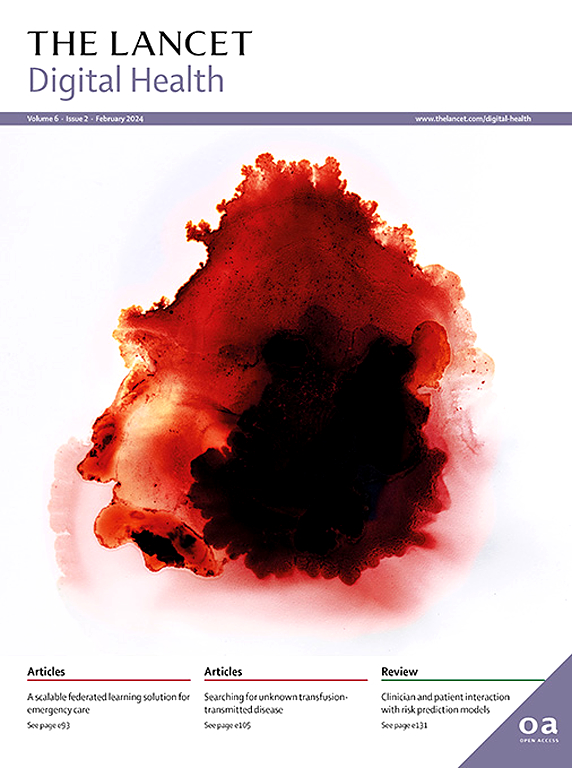对健康女性捐献者乳腺组织中与衰老相关的核形态进行深度学习评估,以预测未来罹患乳腺癌的风险:一项回顾性队列研究
IF 24.1
1区 医学
Q1 MEDICAL INFORMATICS
引用次数: 0
摘要
背景细胞衰老与癌症有关,它既是限制细胞自主增殖的屏障机制,也是分泌促炎旁分泌因子的肿瘤促进微环境机制。由于大多数研究都是在非人类模型中完成的,而且衰老的性质多种多样,因此人们对衰老细胞在人类癌症发展中的确切作用还不是很了解。此外,每年有 100 多万例非恶性乳腺活检,这可能是进行风险分层的重要资源。在这项回顾性队列研究中,我们将基于核形态的单细胞深度学习衰老预测因子应用于印第安纳大学西蒙癌症中心(印第安纳波利斯,美国)科曼组织库(KTB)中健康女性捐献者的血苏木精和伊红染色乳腺活检样本的组织学图像。所有在2009年至2019年期间为研究目的接受核心活检的KTB参与者(年龄≥18岁)均符合研究条件。使用经过验证的模型预测上皮(末端导管小叶单位 [TDLUs] 和非 TDLU 上皮)、基质和脂肪组织区的衰老,这些模型以前曾在电离辐射(IR)、复制衰竭(或复制衰老;RS)或抗霉素 A、阿扎那韦-利托那韦和多柔比星(AAD)暴露诱导衰老的细胞上进行过训练。为了给我们基于衰老的癌症预测结果设定基准,我们根据组织捐献时的特征为 35 岁及以上的参与者生成了 5 年 Gail 评分--目前临床上预测乳腺癌风险的金标准。主要结果是根据病例(截至数据截止日 2022 年 7 月 31 日已确诊为乳腺癌的参与者)和对照组(未确诊为乳腺癌的参与者)的衰老预测得分,通过逻辑模型对每个组织区块进行估算,得出患乳腺癌的几率。截至数据截止日期(中位数随访时间为 10 年 [7-11]),86 例(2-0%)在捐献日期后平均 4-8 年(SD 2-84)患上乳腺癌,4296 例(98-0%)未确诊乳腺癌。在这 86 例病例中,我们发现脂肪特异性 IR 和 AAD 衰老预测得分与对照组相比存在显著差异。风险分析表明,脂肪组织IR模型得分处于上半部(高于中位数)的人患乳腺癌的几率更高(几率比[OR] 1-71 [95% CI 1-10-2-68];P=0-019),而脂肪AAD模型显示患乳腺癌的几率降低(OR 0-57 [0-36-0-88];P=0-013)。对于其他组织区划和 RS 模型,没有发现明显的关联(除了通过 IR 模型的基质组织,其患乳腺癌的几率更高 [OR 1-59, 1-03-2-49])。同时具有两种脂肪风险因素的个体的OR值为3-32(1-68-7-03;P=0-0009)。5年Gail评分高于中位数的参与者与评分低于中位数的参与者相比,患癌症的OR值为2-33(1-46-3-82;p=0-0012)。在将盖尔评分与我们的脂肪 AAD 风险模型相结合时,我们发现同时具有这两个预测因子的个体的 OR 值为 4-70 (2-29-10-90; p<0-0001)。当将盖尔评分与我们的脂肪 IR 模型相结合时,我们发现同时具有这两个预测因子的个体的 OR 值为 3-45 (1-77-7-24; p=0-0002)。与目前的临床基准 Gail 模型相比,多种模型的组合提高了对未来乳腺癌的预测能力。我们的研究结果表明,基于显微镜图像的深度学习模型在预测未来癌症发展方面发挥着重要作用。此类模型可纳入当前的乳腺癌风险评估和筛查方案。本文章由计算机程序翻译,如有差异,请以英文原文为准。
Deep learning assessment of senescence-associated nuclear morphologies in mammary tissue from healthy female donors to predict future risk of breast cancer: a retrospective cohort study
Background
Cellular senescence has been associated with cancer as either a barrier mechanism restricting autonomous cell proliferation or a tumour-promoting microenvironmental mechanism that secretes proinflammatory paracrine factors. With most work done in non-human models and the heterogeneous nature of senescence, the precise role of senescent cells in the development of cancer in humans is not well understood. Furthermore, more than 1 million non-malignant breast biopsies are taken every year that could be a major resource for risk stratification. We aimed to explore the clinical relevance for breast cancer development of markers of senescence in mammary tissue from healthy female donors.
Methods
In this retrospective cohort study, we applied single-cell deep learning senescence predictors, based on nuclear morphology, to histological images of haematoxylin and eosin-stained breast biopsy samples from healthy female donors at the Komen Tissue Bank (KTB) at the Indiana University Simon Cancer Center (Indianapolis, IN, USA). All KTB participants (aged ≥18 years) who underwent core biopsies for research purposes between 2009 and 2019 were eligible for the study. Senescence was predicted in the epithelial (terminal duct lobular units [TDLUs] and non-TDLU epithelium), stromal, and adipose tissue compartments using validated models, previously trained on cells induced to senescence by ionising radiation (IR), replicative exhaustion (or replicative senescence; RS), or antimycin A, atazanavir–ritonavir, and doxorubicin (AAD) exposures. To benchmark our senescence-based cancer prediction results, we generated 5-year Gail scores—the current clinical gold standard for breast cancer risk prediction—for participants aged 35 years and older on the basis of characteristics at the time of tissue donation. The primary outcome was estimated odds of breast cancer via logistic modelling for each tissue compartment based on predicted senescence scores in cases (participants who had been diagnosed with breast cancer as of data cutoff, July 31, 2022) and controls (those who had not been diagnosed with breast cancer).
Findings
4382 female donors (median age at donation 45 years [IQR 34–57]) were eligible for the study. As of data cutoff (median follow-up of 10 years [7–11]), 86 (2·0%) had developed breast cancer a mean of 4·8 years (SD 2·84) after date of donation and 4296 (98·0%) had not received a breast cancer diagnosis. Among the 86 cases, we found significant differences in adipose-specific IR and AAD senescence prediction scores compared with controls. Risk analysis showed that individuals in the upper half (above the median) of scores for the adipose tissue IR model had higher odds of developing breast cancer (odds ratio [OR] 1·71 [95% CI 1·10–2·68]; p=0·019), whereas the adipose AAD model revealed a reduced odds of developing breast cancer (OR 0·57 [0·36–0·88]; p=0·013). For the other tissue compartments and the RS model, no significant associations were found (except for stromal tissue via the IR model, had higher odds of developing breast cancer [OR 1·59, 1·03–2·49]). Individuals with both of the adipose risk factors had an OR of 3·32 (1·68–7·03; p=0·0009). Participants with 5-year Gail scores above the median had an OR for development of cancer of 2·33 (1·46–3·82; p=0·0012) compared with those with scores below the median. When combining Gail scores with our adipose AAD risk model, we found that individuals with both of these predictors had an OR of 4·70 (2·29–10·90; p<0·0001). When combining the Gail score with our adipose IR model, we found that individuals with both predictors had an OR of 3·45 (1·77–7·24; p=0·0002).
Interpretation
Assessment of senescence-associated nuclear morphologies with deep learning allows prediction of future cancer risk from normal breast biopsy samples. The combination of multiple models improved prediction of future breast cancer compared with the current clinical benchmark, the Gail model. Our results suggest an important role for microscope image-based deep learning models in predicting future cancer development. Such models could be incorporated into current breast cancer risk assessment and screening protocols.
Funding
Novo Nordisk Foundation, Danish Cancer Society, and the US National Institutes of Health.
求助全文
通过发布文献求助,成功后即可免费获取论文全文。
去求助
来源期刊

Lancet Digital Health
Multiple-
CiteScore
41.20
自引率
1.60%
发文量
232
审稿时长
13 weeks
期刊介绍:
The Lancet Digital Health publishes important, innovative, and practice-changing research on any topic connected with digital technology in clinical medicine, public health, and global health.
The journal’s open access content crosses subject boundaries, building bridges between health professionals and researchers.By bringing together the most important advances in this multidisciplinary field,The Lancet Digital Health is the most prominent publishing venue in digital health.
We publish a range of content types including Articles,Review, Comment, and Correspondence, contributing to promoting digital technologies in health practice worldwide.
 求助内容:
求助内容: 应助结果提醒方式:
应助结果提醒方式:


